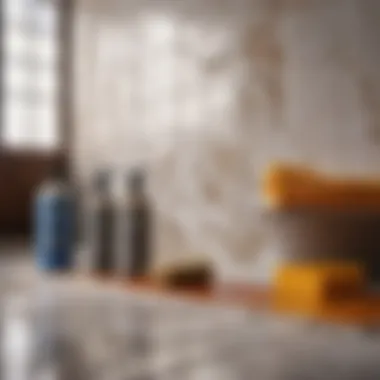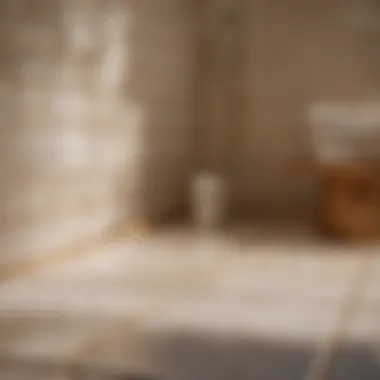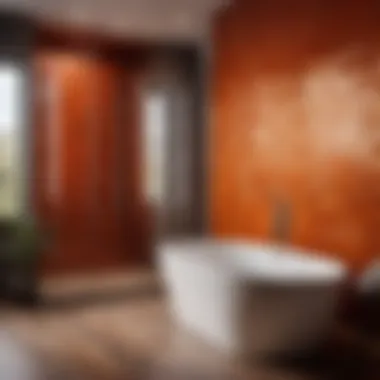Transform Your Bathroom with Expert Tips on Painting Bathroom Tiles


Materials:
- Primer: Purchase a high-quality bonding primer formulated for use on tiles. Measure according to the size of your bathroom walls.
- Paint: Select a durable, waterproof paint suitable for tiles in a color of your choice. Calculate the required amount based on the surface area to be painted.
- Paintbrushes/Rollers: Acquire high-quality brushes and rollers for smooth application. Ensure different sizes for corners and larger areas.
- Painter's Tape: Get painter's tape to protect areas you don't want to paint. Measure the length needed for precise application.
- Sandpaper: Purchase fine-grit sandpaper to lightly sand the tiles before applying the primer. Measure accordingly.
DIY Steps:
- Clean the Tiles: Thoroughly clean the tiles to remove any dirt, grease, or grime. Use a suitable cleaner and ensure the surface is dry before proceeding.
- Sand the Tiles: Gently sand the tiles with the sandpaper to create a slight texture for better paint adhesion. Wipe off any dust with a clean cloth.
- Apply Primer: Using a brush or roller, apply a thin, even coat of primer onto the tiles. Allow it to dry as per the manufacturer's instructions.
- Paint the Tiles: Start painting the tiles with the chosen color, applying multiple thin coats for even coverage. Let each coat dry completely before adding the next.
- Remove Painter's Tape: Once the paint is dry, carefully remove the painter's tape to reveal clean edges and lines.
Technical Aspects:
- Timing: Ensure you have ample time to complete each step without rushing the process.
- Tools: Utilize the appropriate tools for each stage, from cleaning to painting, for a professional finish.
- Techniques: Follow recommended techniques such as feathering edges and overlapping strokes for a seamless look.
- Drying Time: Allow sufficient drying time between coats to prevent smudges or uneven finish.
DIY Project Process:
- Plan and Prepare: Organize your materials, set up your workspace, and ensure proper ventilation before starting the project.
- Execution: Follow the outlined steps diligently, focusing on precision and attention to detail for a flawless outcome.
- Troubleshooting Tips: In case of drips, bubbles, or uneven coverage, sand lightly and apply additional coats as needed for correction.
- Enjoy the Result: Step back and appreciate your newly painted bathroom tiles, adding a fresh and personalized touch to your space.
Preparation Before Painting
When embarking on the journey of revamping your bathroom by painting the tiles, the initial step of Preparation Before Painting cannot be underestimated. Before you even think about picking up a paintbrush, meticulous planning and preparation are essential. This phase sets the foundation for a successful tile painting project and ensures the end result is both visually appealing and long-lasting. Through careful consideration and attention to detail, you can avoid common pitfalls and achieve a professional finish that transforms your bathroom into a stylish oasis.
Gathering Materials and Tools
To kickstart your tile painting project effectively, you need to gather a range of materials and tools that will facilitate the process seamlessly. Each item serves a specific purpose in the painting journey:
Primer


Primer plays a crucial role in preparing the tiles for the paint application. It acts as a bonding agent, promoting adhesion between the existing tile surface and the new paint. Choose a high-quality primer specifically designed for tile applications to ensure optimum results. The key characteristic of a primer lies in its ability to create a smooth, uniform surface that enhances paint adhesion, leading to a durable and long-lasting finish. While primers offer excellent benefits such as improved paint durability and adhesion, they may require proper ventilation during application.
Tile Paint
Tile paint is the star of the show when it comes to transforming your bathroom tiles into a stunning focal point. Opt for epoxy paint or tile-specific paint based on your preferences and desired outcome. These paints are formulated to withstand moisture and frequent cleaning, making them ideal for bathroom environments. The key characteristic of tile paint is its ability to adhere to tiled surfaces effectively, providing a durable and water-resistant finish that enhances the visual appeal of your bathroom. While tile paints offer numerous benefits such as easy application and durability, it is essential to follow manufacturer instructions for proper curing and maintenance.
Paintbrushes
Selecting the right paintbrushes is essential for achieving a smooth and even finish on your tiles. Invest in high-quality paintbrushes that are suitable for the type of paint you are using to ensure precise application and professional results. The key characteristic of paintbrushes lies in their bristle quality and size, which determines the coverage and finish of the paint. Quality paintbrushes help in achieving clean and uniform paint application, elevating the overall appearance of your painted tiles. While paintbrushes offer advantages such as precise application and versatility, they require proper cleaning and maintenance for prolonged use.
Painter's Tape
Painter's tape is a handy tool that aids in achieving clean and crisp paint lines while protecting adjacent surfaces from accidental paint splatters. The key characteristic of painter's tape is its ability to adhere securely to surfaces without causing damage or leaving adhesive residue. It is a popular choice for creating sharp edges and defining areas for paint application. While painter's tape provides benefits such as easy removal and precise masking, it is essential to apply it carefully to ensure seamless results.
Sandpaper
Sandpaper plays a vital role in preparing the tile surface before painting by creating a rough texture that promotes paint adhesion. Choose the appropriate grit sandpaper based on the tile material and condition to achieve optimal results. The key characteristic of sandpaper lies in its abrasive surface, which helps in removing dirt, grime, and old finishes from tiles. Proper sanding ensures a clean and smooth surface for paint application, enhancing the adhesion and durability of the paint. While sandpaper offers benefits such as surface preparation and paint adhesion, it is crucial to follow safety precautions during use to avoid injury.
Painting the Bathroom Tiles
When embarking on the journey of revamping your bathroom, one of the most impactful steps is painting the bathroom tiles. This crucial task can completely transform the aesthetic of your bathroom, giving it a fresh and updated look. Choosing the right paint and applying it correctly are essential elements in this article that will guide you through the process seamlessly. Not only does painting the bathroom tiles enhance the overall appeal of your bathroom, but it also adds a personal touch and allows for customization according to your preferences.
Choosing the Right Paint
Epoxy Paint
Epoxy paint is a key player when it comes to painting bathroom tiles. Its specific formulation ensures durability and resistance to moisture, making it an ideal choice for areas prone to high humidity like bathrooms. The main characteristic that sets epoxy paint apart is its ability to adhere firmly to tile surfaces, providing a long-lasting finish that can withstand regular use. Due to its renowned durability and water-resistant properties, epoxy paint is a popular choice for this article, where the goal is to achieve a lasting and high-quality paint job. One unique feature of epoxy paint is its seamless application process, which allows for a smooth and uniform finish. While epoxy paint excels in longevity and resilience, it may require proper ventilation during application due to its strong odor.


Tile-Specific Paint
Tile-specific paint is specially formulated for painting tiles, offering excellent adhesion and durability. This type of paint is designed to bond effectively with tile surfaces, ensuring a lasting finish that resists chipping and peeling. The key characteristic of tile-specific paint is its ability to provide a professional-looking result without the need for extensive preparation. This makes it a beneficial choice for those seeking a convenient and efficient painting solution for their bathroom tiles. One unique feature of tile-specific paint is its versatility, allowing for use on various tile materials without compromising finish quality. While tile-specific paint boasts easy application and durability, some variants may have limited color options compared to traditional paint choices.
Applying the Paint
Using a Roller
Utilizing a roller for painting the bathroom tiles offers several advantages, including speed and efficiency in covering large areas. The key characteristic of using a roller is its ability to deliver a smooth and uniform coat of paint, ensuring a professional finish. This method is a popular choice for this article as it enables quick application of paint, saving time and effort during the painting process. One unique feature of using a roller is its adaptability to different tile textures, allowing for consistent coverage even on uneven surfaces. While using a roller accelerates the painting process and yields smooth results, it may require practice to achieve optimal coverage and avoid drip marks.
Applying Multiple Coats
Applying multiple coats of paint is essential for achieving a flawless and durable finish on bathroom tiles. The key characteristic of applying multiple coats is the increased thickness and resilience it provides, enhancing the paint's longevity and protective qualities. This method is a beneficial choice for this article as it ensures thorough coverage and color richness, resulting in a vibrant and long-lasting appearance. One unique feature of applying multiple coats is the ability to correct any unevenness or imperfections from previous coats, guaranteeing a seamless and professional outcome. While applying multiple coats improves the durability and aesthetic appeal of painted tiles, it may extend the overall painting timeline.
Painting in Sections
Dividing the painting process into sections ensures systematic coverage and efficient application of paint on bathroom tiles. The key characteristic of painting in sections is the organized approach it offers, allowing for thorough and controlled painting in manageable areas. This method is a popular choice for this article as it minimizes the risk of missed spots and promotes consistency throughout the painting project. One unique feature of painting in sections is the ability to focus on one part at a time, ensuring attention to detail and quality finish in each area. While painting in sections enhances precision and workflow during the painting process, it may require proper planning to maintain a cohesive look across all sections.
Letting the Paint Cure
Drying Time
The drying time of the paint is a critical aspect that contributes to the overall success of painting bathroom tiles. The key characteristic of sufficient drying time is the establishment of a durable and hardened finish that adheres securely to the tile surface. Optimal drying time is essential for preventing smudges or damage to the newly painted tiles, ensuring a flawless and professional outcome. This feature is a beneficial choice for this article as it promotes long-term adhesion and resilience, guaranteeing a lasting and beautiful finish. One unique aspect of proper drying time is the opportunity it provides for inspecting the painted tiles and making any necessary touch-ups before finalizing the project. While ensuring adequate drying time enhances the longevity and quality of the painted tiles, it may require patience and careful handling during the curing process.
Avoiding Water Exposure
Avoiding water exposure is vital to maintain the integrity and appearance of freshly painted bathroom tiles. The key characteristic of protecting the tiles from water exposure is preserving the paint's longevity and preventing premature wear or degradation. Shielding the painted tiles from water is a beneficial choice for this article as it safeguards the quality and aesthetic appeal of the newly revamped bathroom. One unique feature of avoiding water exposure is the promotion of good maintenance practices, such as using gentle cleaners and avoiding harsh abrasives that could compromise the paint finish. While protecting against water exposure ensures the durability and beauty of painted tiles, it may require regular upkeep and mindfulness to prevent water damage over time.


This detailed guide on revamping your bathroom by painting the tiles emphasizes the importance of each step, from choosing the right paint to applying it correctly and ensuring proper aftercare. By following these meticulous instructions and in-depth insights, you can successfully transform your bathroom into a personalized oasis, enjoying the fruitful results of your tile painting project.
Aftercare and Maintenance
After completing the process of painting your bathroom tiles, proper aftercare and maintenance are essential to ensure the longevity and durability of the new finish. An often-overlooked step, aftercare and maintenance play a crucial role in preserving the freshly painted tiles and keeping them looking pristine for years to come. By following a few simple yet effective strategies, you can protect your investment and maintain the aesthetic appeal of your bathroom.
Cleaning the Painted Tiles
Keeping your painted tiles clean is paramount to maintaining their appearance. Using gentle cleaners specifically formulated for painted surfaces is recommended to prevent damage to the paint while effectively removing dirt and grime. These cleaners are mild yet efficient, ensuring that the paint stays vibrant without deteriorating over time.
Regular Maintenance
Regularly inspecting the painted tiles for any signs of wear and tear is vital. By checking for chipping or peeling at periodic intervals, you can address any issues promptly before they escalate. This proactive approach helps to preserve the integrity of the paint and prevents minor damages from becoming significant repairs.
Checking for Chipping
One crucial aspect of regular maintenance is checking for chipping along the painted surface. By examining the tiles closely, you can identify any areas where the paint may be lifting or chipping away. Promptly addressing these areas with touch-up paint can prevent further deterioration and sustain the overall look of the tiles.
Repairing Small Damages
In the event of minor damages such as scratches or small chips, repairing them promptly is key to preserving the appearance of the painted tiles. Utilizing repair kits designed for painted surfaces, you can seamlessly fix minor imperfections without the need for extensive touch-ups. This proactive approach helps to maintain the uniformity of the painted surface.
Refreshing the Look
Over time, even well-maintained painted tiles may require a refresh to update the aesthetic of your bathroom. By repainting when needed, you can breathe new life into the space and revitalize its ambiance. Experimenting with different colors offers an opportunity to infuse personality into the bathroom decor, allowing you to customize the look according to your preference.
Repainting When Needed
When the painted tiles start to show signs of wear or fading, repainting is a practical solution to rejuvenate the visual appeal. By choosing high-quality tile paint and meticulously applying new coats, you can achieve a fresh and flawless finish. This process not only enhances the appearance of the bathroom but also extends the lifespan of the tiles.
Experimenting with Colors
Changing the color scheme of the bathroom tiles can dramatically alter the overall ambiance of the space. Experimenting with different colors allows you to explore various design possibilities and create a personalized aesthetic. Whether opting for a subtle tone or a bold hue, selecting the right color can transform the bathroom into a stylish and cohesive retreat.







